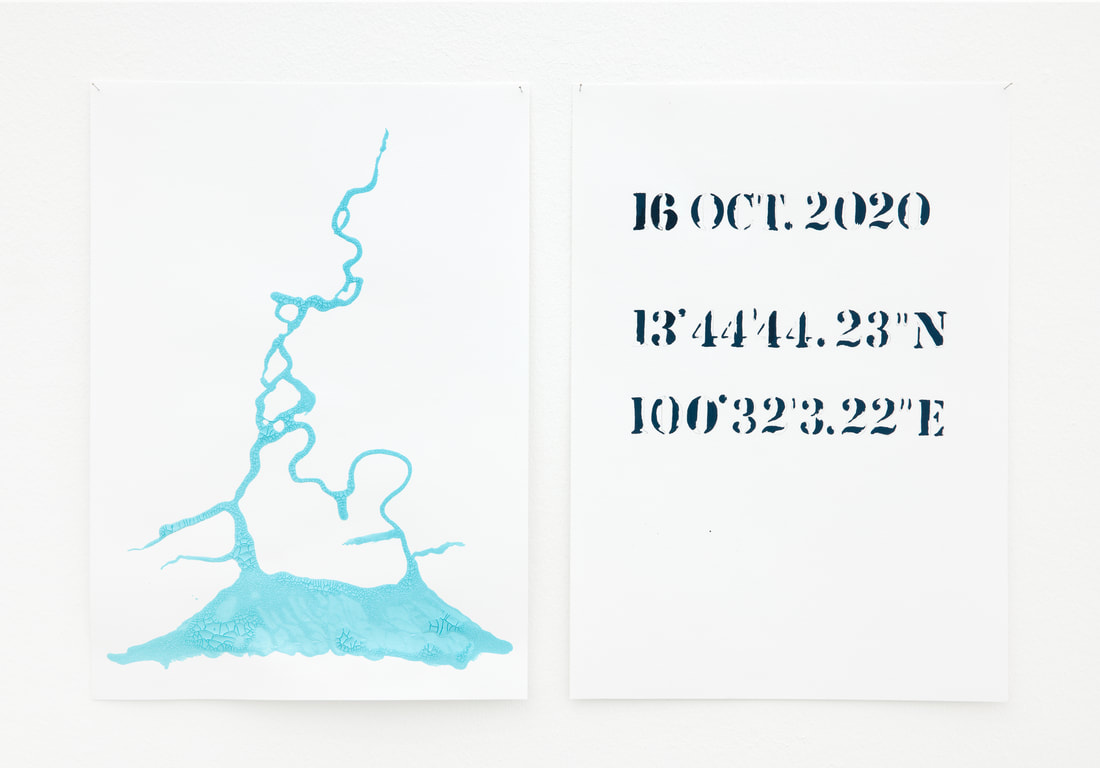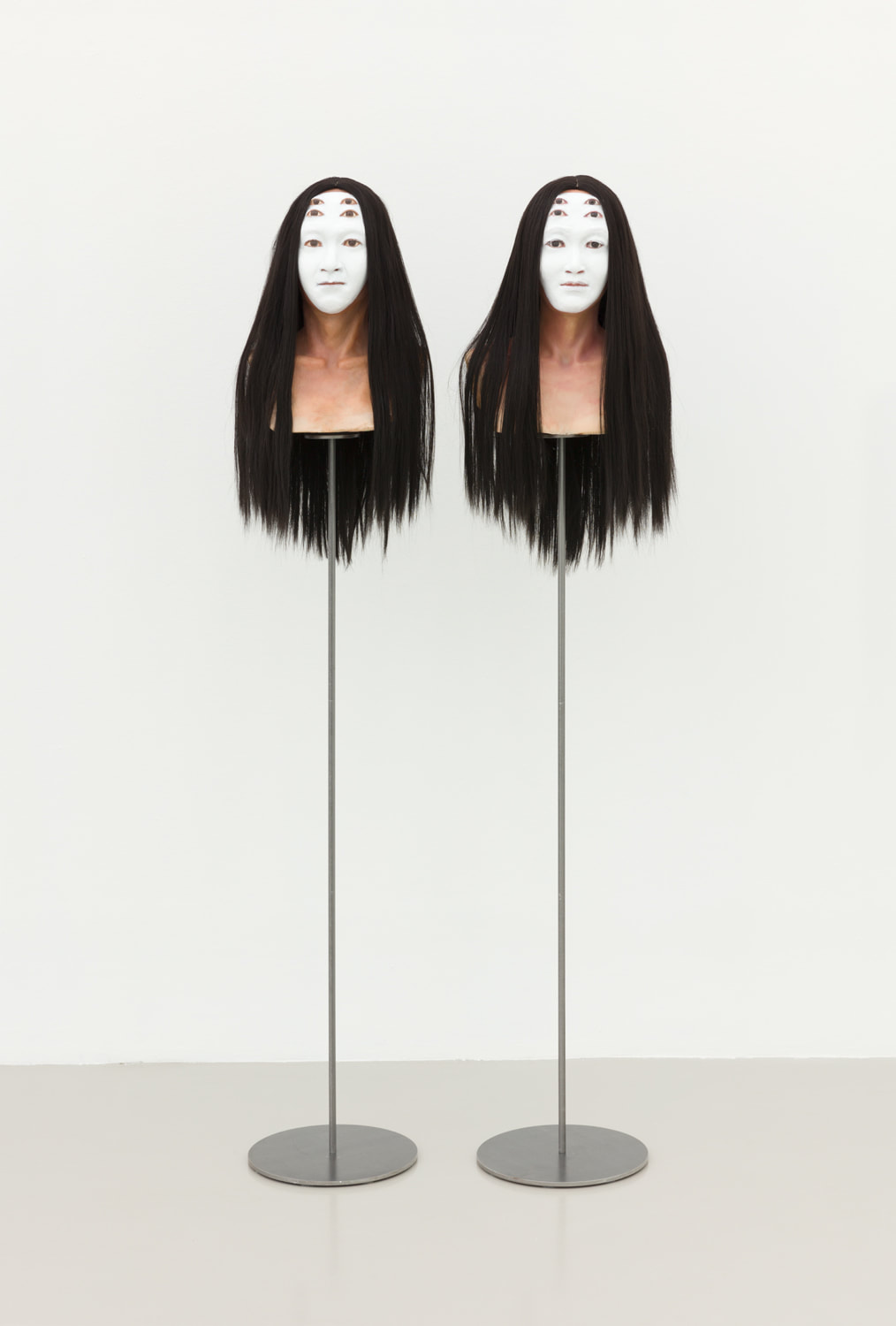The Tenebrous Spiral Staircase of the -
by Chitti Kasemkitvatana
4 September - 6 November, 2021
Wednesday - Sunday, 12h00 - 18h00
Gallery VER
by Chitti Kasemkitvatana
4 September - 6 November, 2021
Wednesday - Sunday, 12h00 - 18h00
Gallery VER
|
-, 2021.
Thaitone acrylic on 200 gsm watercolour paper and pins. Diptych, 29.7 x 42 cm each. Unique piece. Left : Contour line of the Chao Phraya river or R. Menam drawn from the “Map of the Course of the R. Menam from Ayutthaya to the Sea” (Carte du Cours du Menam depuis Siam jusqu'à la Mer) by Jacques-Nicolas Bellin, 1751 with pencil and Thaitone acrylic colour called "nam-lai" or "flowing water". Right : Date of 16 October 2020 and DMS latitude / longitude of BTS - Siam Station drawn with pencil and Thaitone acrylic colour called "khab", the colour assigned by King Rama VI on Thai flag representing the Monarch. |
|
Untitled, 2021.
Acrylic on birch wood with Pali word '/pa/ṭirūpa' (reform) engraved in Ariyaka alphabet and convex mirror. 105.9 x 188.2 cm. Unique piece. The Ariyaka alphabet was invented by Phra Vajirayana Thera (later, King Rama IV) as an alternative alphabet for Pali. He considered the Khmer alphabet, which was commonly used to write Pali, to be too complicated and decided to create an alphabet that was easier to use and more western in appearance. It was an early evidence in transitional process toward modernity and integration with the west in Rattanakosin era. |
|
Elliptical glints on R. Menam, 2019, 2021.
In collaboration with Nattapol Rojjanarattanangkool. Digital print on Ilford Omnijet Matte 180 gsm paper, mounted on Gator board and aluminum frames. Diptych : 40 x 59.7 cm each. Edition of 10 + 1 AP. Text on the left : Cover page of Bowring Treaty, signed between the British Empire and the Kingdom of Siam on 18 April 1855, and an article from Public Ledger & Daily Advertiser, London, Saturday, October 1st, 1825 : "Sincapore Chronicles have been received to the 1st of April. They contain very important intelligence from Siam. Heretofore the Burman Emperor had treated the Siamese with great insolence, and, indeed, subsequently to 1822, he had carried on a sort of desultory warfare on their frontiers ; but the British invasion caused him to alter his tone wonderfully towards the Siamese. He wrote a letter himself to the King of Siam, offering to repair in person to Bangkok, for the purpose of being present at the funeral obsequies of the late Siamese Monarch, and he coupled this complimeutary proposal with a request that the King of Siam would join forces with him against the English. It is asserted that this communication, for a time, staggered the Siamese ; but in the mean while they learnt the capture, by our forces, of Tavoy, Mergui, and Martaban, places not far distant from their own territory ; and they wisely determined rather to join the conquerors than the conquered. The result was the Embassy , which we learn, by the last accounts from Rangoon, had reached that place, and which was reciprocated by sending an English Officer to Siam. The Siamese have the character of being much more weak and effeminate than the Burmans ; but yet their co-operation against the latter cannot but operate very beneficially towards the progress of the British arms." Text on the right : "LONDON. Saturday. July 9 : According to the letter received at Paris from Prambrichou, dated the 23d of July 1767, from the Bishop of Canathe, Apostolical Vicar of Chochin China, one of the French Missionaries upon his arrival at Camboge learnt there that the Bermas (a people under the dominion of the King of Pegou) had entered into Siam, killed the King, burnt and destroyed the city, and laid waste the whole kingdom. The Mandarines were all put to death or made slaves, and the Bishop of Tabacra, who resided at Siam, was sent away to Pegou. Those of Siamese who escaped the slaughter, are reduced to the greatest degree of misery." - taken from The Newcastle Chronicle. Or, General Weekly Advertiser, July 11th, 1768. |
|
Untitled (paṭirūpa), 2021.
Acrylic and gesso on canvas-boards with Pali word 'paṭirūpa' (reform) in Ariyaka alphabet, acrylic hair and satin ribbon. Dimension variable. Set of 4 canvases, 72 x 24 cm. Unique piece. The Ariyaka alphabet was invented by Phra Vajirayana Thera (later, King Rama IV) as an alternative alphabet for Pali. He considered the Khmer alphabet, which was commonly used to write Pali, to be too complicated and decided to create an alphabet that was easier to use and more western in appearance. It was an early evidence in transitional process toward modernity and integration with the west in Rattanakosin era. |
Inquiry :
Please contact Gallery VER for more information
Phone +66 (0)2 120 6098
Email [email protected]
www.galleryver.com
Please contact Gallery VER for more information
Phone +66 (0)2 120 6098
Email [email protected]
www.galleryver.com






